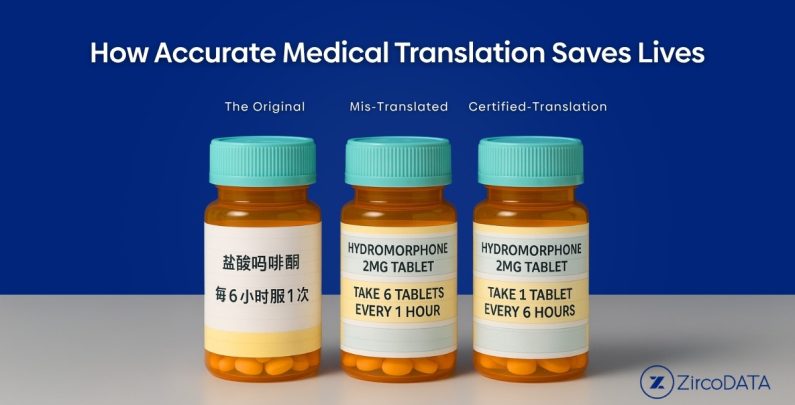
How Accurate Medical Translation Saves Lives
If you’re reading this, you already know that healthcare is built on precision. However, when accurate medical translation is missing and patients and providers don’t share a common language, even the best care can fall apart.
Medical translation isn’t just about converting words. It’s about protecting lives. When done correctly, it ensures that diagnoses, treatments, and medications are clearly understood by everyone involved. On the other hand, when done poorly, the consequences can be serious and sometimes irreversible.
The Critical Role of Accurate Medical Translation
Think of translation as the bridge between a doctor’s knowledge and a patient’s care. Medical translators and interpreters help make that connection by turning complex clinical documents and urgent conversations into clear, accurate information that everyone can understand.
From patient records and discharge summaries to live consultations, accurate translation reduces delays, improves outcomes, and supports continuity of care. In fact, according to The Joint Commission, language barriers are a well-documented patient safety risk and have led to serious sentinel events in hospitals across the world.
When Small Mistakes Become Big Problems
Some translation errors are just inconvenient. But in healthcare, they can be dangerous and even life-threatening:
- “Once a day” becomes “eleven times a day”
- A food allergy goes unrecognised
- Surgical instructions are misunderstood
Importantly, these aren’t hypothetical scenarios. They have happened. As a result, patients have experienced overdoses, extended hospital stays, and legal consequences. For instance, according to the World Health Organization, communication failures are one of the top contributors to medical errors worldwide.
Not All Translators Are Created Equal
Accurate medical translation isn’t just about language. It’s about context, accuracy, and specialisation. A good medical translator doesn’t just know the words. They also understand the discipline and its demands.
Professionals who specialise in fields like paediatrics, oncology, or surgical care bring crucial expertise to their work. The most effective translators continue to develop their skills by:
- Completing certified medical translation courses (AUSIT)
- Attending healthcare conferences and seminars
- Reading peer-reviewed journals and technical updates
Additionally, if your translator isn’t fluent in both the language and the medicine, it’s a risk your patients can’t afford to take.
Why NAATI and ISO Certification Matter in Medical Translation
In Australia, accurate medical translation must meet high standards. NAATI certification (National Accreditation Authority for Translators and Interpreters) ensures that translators and interpreters meet rigorous criteria for language proficiency and accuracy.
ISO 17100 certification also provides a framework for translation quality assurance. Combined, NAATI and ISO-certified services reduce the risk of miscommunication, increase compliance, and help maintain trust in healthcare settings.
So, whether you’re working with patient records, legal documentation, or regulatory reports, using a certified translator isn’t just best practice. It is often a requirement.
AI in Medical Translation: Benefits and Limitations
AI tools are fast, scalable, and surprisingly clever. They are being adopted into our lives more and more each day. But would you trust them to handle life-or-death medical documents on their own?
AI still struggles with several key areas, including:
- Nuanced terminology
- Cultural context
- Legal compliance
In fact, a 2021 study in JAMA Internal Medicine found that Google Translate made critical mistakes when translating emergency discharge instructions. These mistakes sometimes resulted in life-threatening misunderstandings.
Therefore, while AI can be a useful support tool, it is not a substitute for human expertise, especially in high-stakes healthcare environments.
What Happens When Medical Translation Fails
The real-world consequences of mistranslation are well documented. For example:
- Misread dosage leads to overdose
- Device instructions mistranslated, resulting in surgery complications
Each of these errors had serious consequences. In many cases, the patient suffered as a result.
Our Advice? Don’t Cut Corners on Accurate Medical Translation
If you work in healthcare, make certified medical translation a priority. Here’s what we recommend:
- Choose NAATI-certified translators for any clinical or legal documentation
- Build long-term partnerships with language experts who understand your sector
- Give translators full context. It helps them deliver clarity
In short, medical translation should never be left to chance. When accuracy matters, choose certified professionals who specialise in the field.
Medical Translation That Doesn’t Miss a Beat
We take the stress out of accurate medical translation so you can focus on delivering exceptional care. Our translators are all 100 percent NAATI certified and are experts in their field. As a result, we ensure your translations are always fast and accurate.
📄 Want to dive deeper into the most common questions about medical translation?
👉 Read our Medical Translation FAQs
💼 Need certified support for your organisation?
👉 Explore Our Translation Services
Partner with experts. Protect your patients. Translate with precision.
